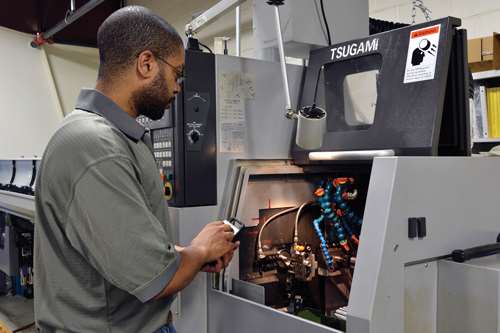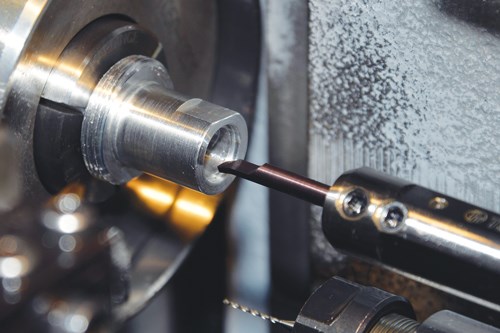Micro-Boring Tool Calms ‘Perfect Storm’ for Medical Parts Fabricator
In one of its first commercial applications, an Ingersoll micro-boring tool has brought process stability to a machining application that the user describes as a “perfect storm.”
#micromachining
In one of its first commercial applications, an Ingersoll micro-boring tool has brought process stability to a machining application that the user describes as a “perfect storm.” Boring the tiny, thin-walled titanium medical part had confounded all previous attempts using a variety of conventional boring bars.
“Now the bores come out with an 8 to 10 microns finish as-machined,” says Shannon Morsching, manufacturing engineer at Medfab Manufacturing Inc., Lakeville, Minn. “Before the retooling, every single piece needed 15 minutes of hand finishing to reach the 16-micron specification.” He adds that sudden, unpredictable edge failures, after as few as 20 parts, disappeared completely. “The new Ingersoll T-Micro tool reliably lasts 250-300 pieces before even starting to show any flank wear. Finally, we have a stable process on a challenging medical component.”
Featured Content
Medfab Manufacturing is a precision machine shop established to support the medical device industry, semi-conductor industry and other high tech OEM industries in their short-to-extended run, tight tolerance machining requirements. The company works as an extension of its clients’ engineering department to improve the manufacturability of parts with the goal of containing costs, improving leadtimes and dovetailing with JIT, KANBAN and custom schedule requirements. Its 16,000-square-foot plant employs 20 people, runs about 70 hours a week and is recruiting a night shift to keep up with demand.
Perfect Storm’ of Adverse Machining Conditions
The workpiece, still in the prototype stage, is a barbed coupling that connects small-bore tubing in a biomedical fluid delivery system. Roughly tubular, it measures about 1 inch long, ¼ inch diameter, with flares at both ends and profiled ODs and IDs leading to walls that vary in thickness between 0.008 and 0.016 inch. It is machined from 3/8 inch Ti 6AL- 4V tubing on a Tsugami Swiss Automatic.
What makes the operation so challenging is the combination of thin walls, the 16-micron surface finish specification, a difficult alloy and the small, high-aspect (>4 to 1) bore. Thin walls are intrinsically unstable during machining, subject to chatter and deflection under light cutting forces. Long chips generated in tight clearances commonly lead to re-cutting or scoring the newly machined finish. Moreover, the small, deep bore itself, with a long-reach boring bar filling up most of the space, works against any decent delivery of cutting fluid to the cutting face or flushing action to evacuate the chips.
“It’s a ‘perfect storm’ of adverse conditions, all working against a decent surface finish,” Mr. Morsching says. “As to boring bar choices, we’d normally have to decide between a husky shank that leaves little clearance for chips or a slimmer shank that facilitates chip evacuation, but deflects too easily and lacks through-the-tool coolant delivery.”
All the Latest Features in One Tool
The new Ingersoll T-Micro boring bar overcomes these problems by combining a very rigid elliptical body with through-the-tool coolant delivery that lubricates the cutting face and flushes out chips. The company introduced the T-Micro line commercially early this year. The elliptical cross section of the body improves rigidity versus conventional round bodies while enhancing chip evacuation. The ellipse’s flatter section aligns with the cutting tip enlarging the space for chip clearance.
The T-Micro system is a two-piece design, consisting of a sleeve and replaceable carbide inserts. This facilitates handling and replacement of the small inserts. A locating pin built into the sleeve ensures repeatability to datum when indexing the inserts. After an insert replacement, operators can resume machining immediately, without resetting the tool.
Early Look Leads to Trial
Mr. Morsching learned about the T-Micro before it was commercialized, and long before he had the problem with the barbed sleeve. In fall 2011, he saw a pre-release demo at an annual distributor tool show, recognized its strategic potential in small medical parts manufacturing and pursued the idea. “Small, precise bores are a staple in our business, so even a small improvement in that process would have wide implications,” he says.
Soon afterward, he reached out to Ingersoll’s Roger Piekarski to discuss the possibility and requested one unit for trial on a part Medfab was running at the time. It was a quick hose disconnect in 316 stainless steel, roughly 1-inch long and 0.750-inch diameter that required boring a 0.343-inch hole 0.300-inch deep. Running at 200 sfm, 0.001 ipr and 0.025-inch DOC, Medfab’s previous tools for the job delivered spotty surface finish quality and broke down unpredictably. Rarely did any tool last more than 50 pieces.
On the next lot of those parts, Mr. Morsching ran trials with the T-Micro on his own, under identical conditions. After 400 pieces, the tool was still as good as new. Surface finishes and chip control were much improved as well. “For the first time, we didn’t have to babysit the operation,” Mr. Morsching says.
Latest, Toughest Challenge
Medfab got the barbed coupling job in spring 2012, while the part was still in the prototype stage. “We knew the alloy, the small bore, the thin walls and tight finish specs would add up to a much steeper challenge than any part of the quick disconnect job,” Mr. Morsching says. “We could see the warning signs.”
Since the job was so demanding and the T-Micro boring tool was still in the evaluation stage, Mr. Morsching again ran the part with the old and new tool under identical conditions. Coolant was a high flash point oil formulation.
The improvement was clear: As-machined finish came in at 8 to 10 microns, well within spec even after 250 to 300 pieces. “We switched out the inserts at 250 pieces just as a precaution,” he says. Mr. Morsching also ramped up the parameters, completing a 3½-minute boring operation in 3 minutes. “At those settings, we have a stable micro-boring operation that can run unattended and requires no hand work to meet finish specs.”
Based on experience on stainless steel and titanium, Mr. Morsching plans to apply the T-Micro tool on workpieces of tantalum, MM35P (machinability similar to Waspaloy) and other high nickel alloys.
RELATED CONTENT
-
Tools and Technologies for Deep Hole Drilling
Understanding the challenges of deep hole drilling and knowing how to select and apply the appropriate tools will help a shop profit from this operation.
-
When Thread Milling Makes Sense
Threading a workpiece is a fundamental metalworking process that every manufacturing engineer takes for granted.
-
Bar Feeder Basics
Some primary factors are often overlooked when considering how to justify the implementation of a bar feeder for turning operations.









